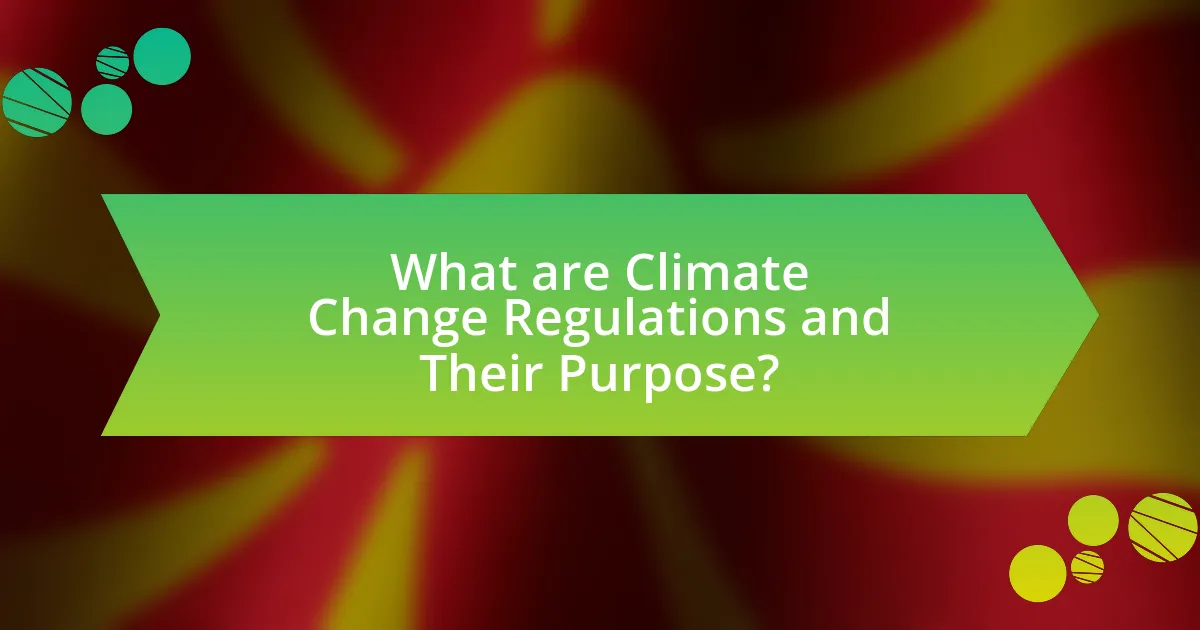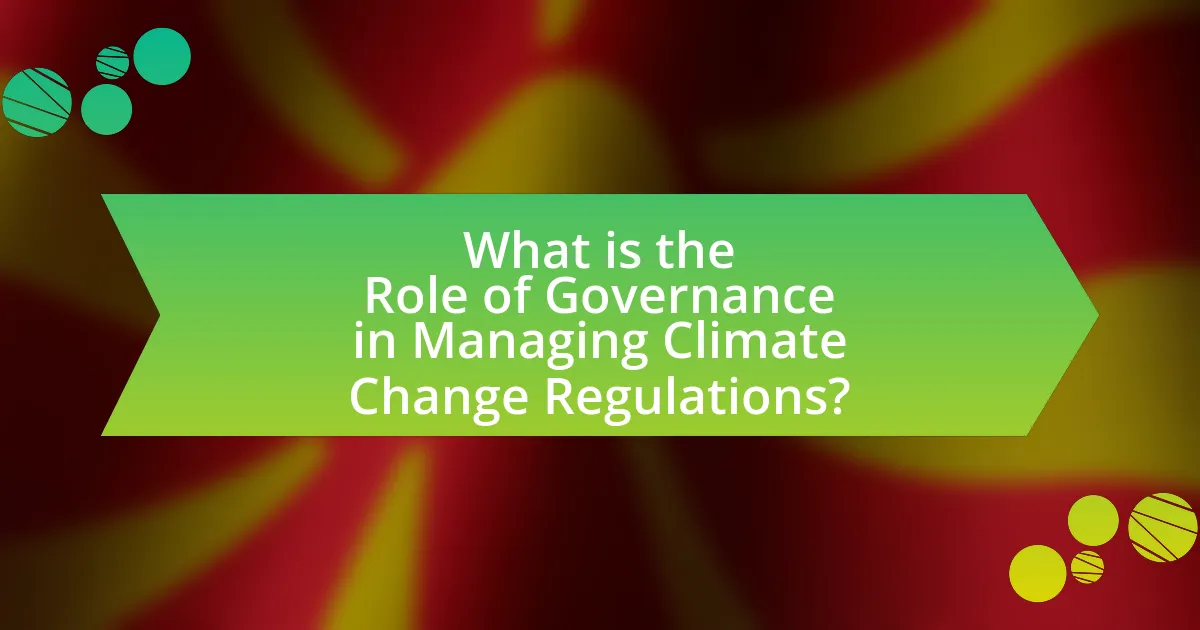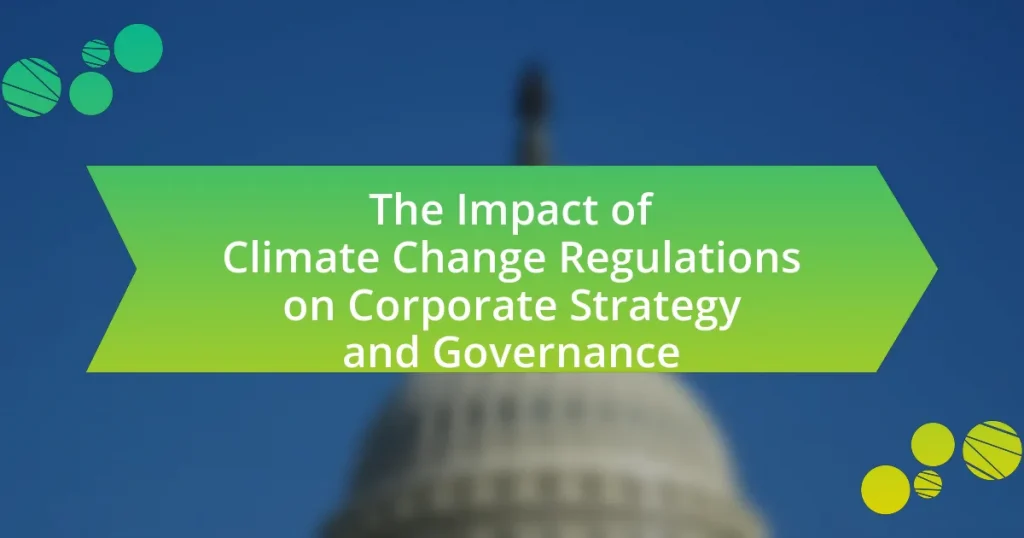The article examines the impact of climate change regulations on corporate strategy and governance, highlighting the legal frameworks established by governments to mitigate climate change effects through greenhouse gas emission controls and sustainable practices. It discusses how these regulations influence corporate operations, necessitating investments in cleaner technologies and altering business practices to ensure compliance. Key regulations such as emissions trading systems, carbon taxes, and renewable energy mandates are analyzed for their effects on corporate strategies, risk management, and stakeholder engagement. The article also emphasizes the growing importance of governance structures in managing climate-related risks and aligning corporate actions with regulatory expectations, ultimately driving sustainability in the corporate sector.

What are Climate Change Regulations and Their Purpose?
Climate change regulations are legal frameworks established by governments to mitigate the effects of climate change by controlling greenhouse gas emissions and promoting sustainable practices. Their primary purpose is to reduce environmental harm, protect public health, and ensure compliance with international agreements, such as the Paris Agreement, which aims to limit global warming to well below 2 degrees Celsius. These regulations often include emissions trading systems, renewable energy mandates, and efficiency standards, which collectively drive innovation and investment in cleaner technologies, thereby influencing corporate strategies and governance.
How do Climate Change Regulations impact corporate operations?
Climate change regulations significantly impact corporate operations by imposing compliance requirements that influence business practices and strategic decision-making. Companies must adapt to these regulations by investing in sustainable technologies, altering supply chains, and enhancing reporting practices to meet environmental standards. For instance, the European Union’s Emissions Trading System mandates that companies limit their greenhouse gas emissions, leading to increased operational costs and necessitating investments in cleaner technologies. Additionally, firms that fail to comply with these regulations may face substantial fines and reputational damage, further affecting their market position and profitability.
What specific regulations are most influential on corporate strategy?
The specific regulations most influential on corporate strategy include emissions trading systems, carbon taxes, and renewable energy mandates. Emissions trading systems, such as the European Union Emissions Trading System, create a market for carbon credits, incentivizing companies to reduce greenhouse gas emissions. Carbon taxes, implemented in countries like Canada, directly impose a cost on carbon emissions, prompting businesses to adopt cleaner technologies. Renewable energy mandates, seen in various jurisdictions, require a certain percentage of energy to come from renewable sources, influencing corporate investment decisions and operational strategies. These regulations shape corporate strategies by driving innovation, altering cost structures, and influencing market competitiveness.
How do companies adapt to comply with these regulations?
Companies adapt to comply with climate change regulations by implementing sustainability initiatives and enhancing their governance structures. These adaptations often include adopting renewable energy sources, improving energy efficiency, and integrating environmental considerations into their business strategies. For instance, a report by the Carbon Disclosure Project indicates that over 70% of companies have set science-based targets to reduce greenhouse gas emissions, demonstrating a proactive approach to regulatory compliance. Additionally, firms may establish dedicated sustainability teams to oversee compliance efforts and ensure alignment with regulatory requirements, thereby reinforcing their commitment to environmental stewardship.
Why are Climate Change Regulations becoming increasingly important?
Climate change regulations are becoming increasingly important due to the urgent need to mitigate environmental impacts and promote sustainability. As global temperatures rise and extreme weather events become more frequent, governments and organizations recognize that regulatory frameworks are essential for reducing greenhouse gas emissions and fostering a transition to renewable energy sources. For instance, the Intergovernmental Panel on Climate Change (IPCC) reports that limiting global warming to 1.5 degrees Celsius requires immediate and substantial reductions in emissions, underscoring the necessity for robust regulations. Additionally, businesses face growing pressure from stakeholders, including investors and consumers, to adopt environmentally responsible practices, making compliance with climate regulations critical for maintaining competitiveness and reputation.
What global trends are driving the need for these regulations?
The global trends driving the need for climate change regulations include increasing climate-related disasters, heightened public awareness of environmental issues, and the transition to sustainable energy sources. Climate-related disasters, such as wildfires and hurricanes, have intensified, leading to economic losses estimated at over $300 billion annually, which underscores the urgency for regulatory frameworks. Public awareness has surged, with surveys indicating that over 70% of people prioritize climate action, pressuring governments and corporations to adopt stricter regulations. Additionally, the global shift towards renewable energy, with investments in clean technologies exceeding $500 billion in 2021, necessitates regulations to guide corporate strategies and governance in alignment with sustainability goals.
How do public perceptions of climate change influence regulatory frameworks?
Public perceptions of climate change significantly influence regulatory frameworks by shaping the political and social landscape in which these regulations are developed. When a majority of the public expresses concern about climate change, policymakers are more likely to respond with stringent regulations aimed at reducing greenhouse gas emissions and promoting sustainability. For instance, surveys indicate that in countries where public concern about climate change is high, such as in the European Union, governments have implemented comprehensive climate policies, including the European Green Deal, which aims to make Europe the first climate-neutral continent by 2050. This correlation between public sentiment and regulatory action demonstrates that heightened awareness and concern can lead to more robust environmental legislation, as seen in the increased adoption of renewable energy standards and emissions targets in response to public advocacy.

How do Climate Change Regulations Affect Corporate Strategy?
Climate change regulations significantly influence corporate strategy by compelling companies to integrate sustainability into their business models. These regulations often require firms to reduce greenhouse gas emissions, adopt renewable energy sources, and enhance energy efficiency, which can lead to increased operational costs and necessitate investment in new technologies. For instance, the implementation of the European Union’s Emissions Trading System has driven companies to innovate and develop low-carbon technologies to remain competitive. Additionally, firms that proactively adapt to these regulations can enhance their brand reputation and attract environmentally conscious consumers, as evidenced by a 2021 McKinsey report indicating that 70% of consumers are willing to pay more for sustainable products. Thus, climate change regulations not only shape compliance strategies but also create opportunities for competitive advantage through sustainability initiatives.
What strategic changes do companies implement in response to regulations?
Companies implement strategic changes such as adopting sustainable practices, enhancing compliance frameworks, and investing in green technologies in response to regulations. For instance, many firms have shifted towards renewable energy sources to meet emissions targets set by climate regulations, thereby reducing their carbon footprint. Additionally, companies often revise their supply chain management to ensure compliance with environmental standards, which can include sourcing materials from sustainable suppliers. A notable example is the automotive industry, where manufacturers like Ford and General Motors have committed to producing electric vehicles to align with stricter emissions regulations. These strategic adaptations not only help companies comply with legal requirements but also position them competitively in a market increasingly focused on sustainability.
How do companies prioritize sustainability in their strategic planning?
Companies prioritize sustainability in their strategic planning by integrating environmental, social, and governance (ESG) criteria into their core business objectives. This integration often involves setting measurable sustainability goals, such as reducing carbon emissions or increasing resource efficiency, which align with regulatory requirements and stakeholder expectations. For instance, a 2021 McKinsey report highlighted that 70% of executives consider sustainability a top priority for their organizations, indicating a significant shift towards sustainable practices in corporate strategy. Additionally, companies often conduct sustainability assessments and engage in stakeholder dialogues to ensure their strategies are responsive to climate change regulations and societal demands.
What role does innovation play in adapting to climate regulations?
Innovation is crucial for adapting to climate regulations as it enables organizations to develop new technologies and processes that comply with environmental standards. For instance, companies are increasingly investing in renewable energy solutions, such as solar and wind power, to meet regulatory requirements and reduce carbon emissions. According to a report by the International Renewable Energy Agency, global investment in renewable energy reached $300 billion in 2020, demonstrating a significant shift towards sustainable practices driven by regulatory pressures. This innovation not only helps firms comply with laws but also enhances their competitive advantage in a market that increasingly values sustainability.
How do regulations influence corporate risk management strategies?
Regulations significantly influence corporate risk management strategies by mandating compliance with environmental standards and sustainability practices. Companies must adapt their risk management frameworks to address regulatory requirements, which often include emissions reductions, resource management, and reporting obligations. For instance, the implementation of the European Union’s Emissions Trading System has compelled firms to develop strategies that mitigate carbon risks and enhance energy efficiency. This regulatory pressure drives organizations to integrate climate-related risks into their overall risk assessments, ensuring that they remain compliant while also safeguarding their reputations and financial stability.
What risks do companies face if they fail to comply with climate regulations?
Companies that fail to comply with climate regulations face significant legal, financial, and reputational risks. Legal risks include potential fines and penalties imposed by regulatory bodies, which can amount to millions of dollars depending on the severity of the violation. Financial risks arise from increased operational costs due to non-compliance, such as the need for retrofitting facilities or investing in cleaner technologies after the fact. Reputational risks can lead to loss of consumer trust and market share, as stakeholders increasingly favor environmentally responsible companies. For instance, a study by CDP found that companies with strong climate governance can outperform their peers by up to 18% in stock performance, highlighting the financial implications of compliance versus non-compliance.
How can companies leverage compliance as a competitive advantage?
Companies can leverage compliance as a competitive advantage by integrating regulatory adherence into their core business strategies, thereby enhancing their reputation and operational efficiency. By proactively aligning with climate change regulations, companies can differentiate themselves in the marketplace, attract environmentally conscious consumers, and potentially reduce costs through improved resource management. For instance, a study by the Carbon Disclosure Project found that companies with robust sustainability practices can outperform their peers financially, as they often experience lower capital costs and increased investor interest. This demonstrates that compliance not only mitigates risks but also opens avenues for innovation and market leadership.

What is the Role of Governance in Managing Climate Change Regulations?
Governance plays a critical role in managing climate change regulations by establishing frameworks that guide policy implementation and compliance. Effective governance structures ensure that regulations are enforced, promote transparency, and facilitate stakeholder engagement, which is essential for addressing the complexities of climate change. For instance, the Paris Agreement, adopted in 2015, exemplifies how international governance can unify countries in their climate commitments, requiring nations to set and report on their emissions reduction targets. This collaborative approach underscores the importance of governance in aligning corporate strategies with regulatory expectations, ultimately driving sustainable practices and accountability in the corporate sector.
How do corporate governance structures adapt to climate change regulations?
Corporate governance structures adapt to climate change regulations by integrating sustainability into their frameworks and decision-making processes. Companies are increasingly establishing dedicated committees focused on environmental, social, and governance (ESG) issues, which oversee compliance with climate regulations and guide strategic initiatives. For instance, a 2021 report by the World Economic Forum highlighted that 70% of companies are now incorporating climate-related risks into their governance practices, reflecting a shift towards accountability and transparency in environmental performance. This adaptation often includes revising corporate policies, enhancing stakeholder engagement, and aligning executive compensation with sustainability goals, thereby ensuring that climate change considerations are embedded in the overall corporate strategy.
What governance practices are essential for effective climate strategy?
Effective climate strategy requires governance practices such as stakeholder engagement, transparency, and accountability. Stakeholder engagement ensures that diverse perspectives are considered, fostering collaboration and support for climate initiatives. Transparency in reporting climate-related risks and performance builds trust with stakeholders and aligns corporate actions with regulatory expectations. Accountability mechanisms, including setting clear targets and performance metrics, enable organizations to track progress and make necessary adjustments. These practices are supported by frameworks like the Task Force on Climate-related Financial Disclosures (TCFD), which emphasizes the importance of governance in managing climate risks and opportunities.
How does board oversight impact corporate responses to climate regulations?
Board oversight significantly influences corporate responses to climate regulations by ensuring accountability and strategic alignment with sustainability goals. Effective boards prioritize climate-related risks and opportunities, leading to proactive compliance with regulations. For instance, a study by the Harvard Business Review found that companies with strong board oversight on environmental issues are more likely to adopt comprehensive climate strategies and report transparently on their sustainability efforts. This oversight fosters a culture of responsibility, encouraging management to integrate climate considerations into business operations, ultimately enhancing corporate resilience and reputation in a regulatory landscape increasingly focused on environmental sustainability.
What are the implications of climate regulations on stakeholder engagement?
Climate regulations significantly enhance stakeholder engagement by mandating transparency and accountability in corporate practices. These regulations require companies to disclose their environmental impact, which fosters dialogue with stakeholders such as investors, customers, and communities. For instance, the European Union’s Green Deal emphasizes stakeholder involvement in sustainability initiatives, leading to increased collaboration and trust. Furthermore, research from the Harvard Business Review indicates that firms actively engaging stakeholders in climate strategies experience improved reputation and financial performance, demonstrating the positive correlation between regulatory compliance and stakeholder relations.
How do companies communicate their climate strategies to stakeholders?
Companies communicate their climate strategies to stakeholders through various channels, including sustainability reports, press releases, and stakeholder engagement initiatives. These methods provide transparency and detail on the company’s environmental goals, progress, and compliance with climate regulations. For instance, a 2021 report by the Global Reporting Initiative found that 93% of companies disclose their sustainability efforts in formal reports, which are often aligned with frameworks like the Task Force on Climate-related Financial Disclosures (TCFD). This structured communication not only informs stakeholders but also builds trust and accountability in the company’s climate commitments.
What role do investors play in shaping corporate governance related to climate change?
Investors play a crucial role in shaping corporate governance related to climate change by influencing companies to adopt sustainable practices and disclose climate-related risks. Institutional investors, such as pension funds and asset managers, increasingly prioritize environmental, social, and governance (ESG) criteria in their investment decisions, which pressures companies to align their strategies with climate goals. For instance, the Climate Action 100+ initiative, involving over 500 investors managing more than $47 trillion in assets, aims to engage the world’s largest greenhouse gas emitters to improve their climate-related disclosures and reduce emissions. This collective action demonstrates how investor expectations can drive corporate governance reforms that address climate change.
What best practices can companies adopt for effective governance in the context of climate change regulations?
Companies can adopt several best practices for effective governance in the context of climate change regulations, including establishing a dedicated sustainability committee, integrating climate risk into overall business strategy, and ensuring transparent reporting on climate-related metrics. Establishing a sustainability committee allows for focused oversight and accountability, while integrating climate risk into business strategy ensures that companies proactively address potential regulatory impacts. Transparent reporting, guided by frameworks such as the Task Force on Climate-related Financial Disclosures (TCFD), enhances stakeholder trust and aligns corporate actions with regulatory expectations. These practices are supported by evidence showing that companies with robust governance structures are better positioned to navigate regulatory changes and mitigate climate-related risks effectively.






